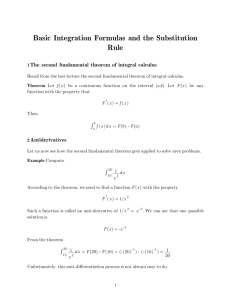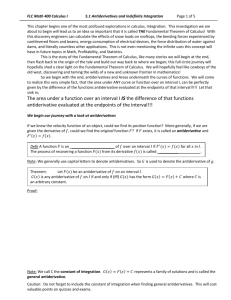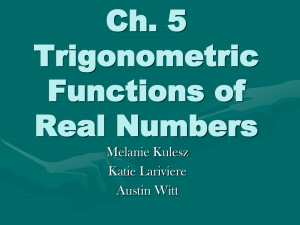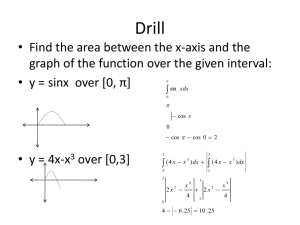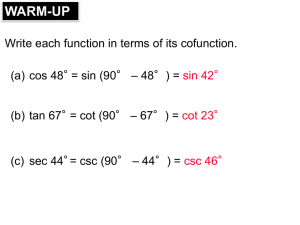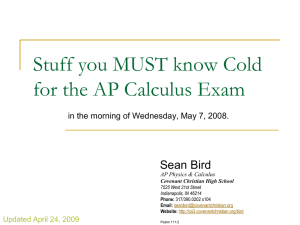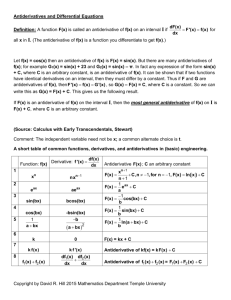Integrals
advertisement
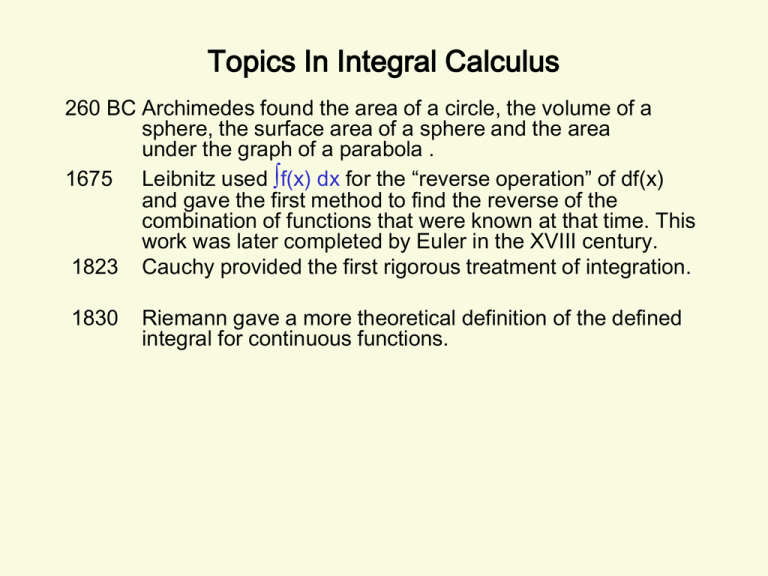
Topics In Integral Calculus 260 BC Archimedes found the area of a circle, the volume of a sphere, the surface area of a sphere and the area under the graph of a parabola . 1675 Leibnitz used ∫f(x) dx for the “reverse operation” of df(x) and gave the first method to find the reverse of the combination of functions that were known at that time. This work was later completed by Euler in the XVIII century. 1823 Cauchy provided the first rigorous treatment of integration. 1830 Riemann gave a more theoretical definition of the defined integral for continuous functions. ANTIDERIVATIVE OF A CONTINUOUS FUNCTION We say that F(x) is an antiderivative (the reverse process of differentiation) of f(x) on an interval I when F’(x) = f(x) for all x in I. For example, x2 is an antiderivative of 2x, since (x2)’ = 2x. Of course x2+C is an anti-derivative of 2x for any real number C. We use the notation,∫ f(x) dx, to represent the set of all antiderivatives of f(x). Thus we write: ∫ 2x dx = x2 + C , where C is any real number Ex 1: Find ∫ x3 dx We need to find an antiderivative for x3 . Since ¼ (x4 )’=4 x3 (¼ x4 )’= x3. So ∫ x3 dx = ¼ x4 + C The general integration formula for power functions will be listed on next slide. Ex 2: ∫sin x dx = - cos x + C , since (- cos x + C)’ = sinx Remark: Let F(x) and G(x) be any two antiderivatives of f(x). Then [ G(x) – F(x)] ’ = G’(x) – F’(x) = f(x) – f(x) = 0. So G(x) - F(x) = C and from here we get G(x) = F(x) + C, this says that any two antiderivatives of f(x) differ only by a constant. Teorem: ∫ f(x) dx = F(x) + C , where F(x) is any antiderivative of f(x). For every known derivative formula, when reading backward, it will give us back its own anti-derivative. For example: (sin x)’ = cos x (cos x)’ = - sinx (tan x)’ = sec2x (sec x )’ = sec x tanx (csc x )’ = - csc x cot x (cot x )’ = - csc2 x (ex ) ’ = ex (ln x)’ = 1/x (sin-1 x)’ = (1- x2) -1/2 ∫ cos x dx = sin x +C ∫ sinx dx = - cos x +C ∫ sec2x dx = tan x + C ∫ sec x tan x dx = sec x + C ∫ csc x cot x dx = - csc x + C ∫ csc 2 x dx = - cot x + C ∫ ex dx = ex + C ∫ 1/x dx = ln x + C , for x>0 ∫ (1- x2) -1/2 dx = sin-1 x + C (tan-1 x)’ = (1+x2) -1 ∫ (1 + x2) -1 dx = tan-1 x + C Remark: 1) If we change 3 in Ex 1 for any number n 1 , we get . ∫ x n dx = x n+1 /(n+1) + C , since (xn+1 /(n+1) )’ = (n+1) x n /(n+1) = x n 2) ∫k f(x)dx = k ∫f(x)dx , since [k ∫f(x)dx ] ’ = k [∫f(x)dx ]’ = k f(x) 3) ∫[f(x) g(x) ] dx = ∫f(x)dx ∫g(x)dx , since [∫[f(x) g(x) ] dx ]’ = f(x) g(x) Ex 3 : Find ∫(8x3 - 10x + 4) dx = ∫(8x3 dx -∫10x dx + ∫4 dx Using 2) … = 8∫x3 dx - 10∫x dx + 4∫dx Using 1) … = 8 x4/4 - 10x2/2 + 4x +C Simplifying… = 2x4 - 5x2 + 4x +C Using 3) … Ex 4 : Find ∫(1- 1/x4 + cos x) dx = ∫dx -∫x -4 dx + ∫cos x dx = x - x -4+1 /(-4+1) + sinx +C = x +(1/3)x -3 +sin x + C The following examples show us that using antiderivative to recover quantities from their derivatives. Ex5: Find the equation of the curve that has a tangent line at any point (x, y) with slope 4 x 3 and passing through the point (2, 5). 2 Sol: y (4 x 3) dx x 3 x C (4 x 3) dx 2 x 3 x C y 2 A t the point (2, 5) : 8 6 C 5 C 3 T hus y 2 x 3 x 3 is the required curve. 2 Ex 6: A company find that the marginal cost when x un its are produced is C ( x ) (0.02 x 40) dollars. If the fixed cost is $1000. Find the cost function and the cost produced 50 units. C (x) (0.02 x 40) dx 0.01 x 40 x C 2 A t C (0) 1000 : C 1000 C ( x ) 0.01 x 40 x 1000 2 A t x 50 : C (50) 25 2000 1000 3050 Ex 7: Knowing that f ’’(x) = 12x- 4 , f ’(2)=10 & f(5)=200, find f(x) f ’(x) = ∫ f ’’(x) dx =∫(12x-4)dx = 6x2 – 4x+C. But f ’(2)= 10. So 10 =6(4)-4(2)+C C=-6 f ’(x) = 6x2 – 4x-6 Then f(x) = ∫(6x2 – 4x-6 ) dx = 2x 3 – 2x 2 – 6x + K But f(5)= 200 , so 200= 2( 5 3 ) – 2(5) 2 – 6(5) + K K = 30 Finally f(x) = 2x 3 – 2x 2 + 6x +30 Ex 8: A car is traveling on a high way (straight line). Its velocity function is given by v(t)= 3t2-2t+65 mph. When t=3 hr. the car was 220 mi from the starting point (origin). Find the position function of the car. 2 3 2 Sol: S ( t ) v ( t ) dt 3 t 2 t 65 dt t t 65 t C 220 S (3) 27 9 195 C C 7 S ( t ) t t 65 t 7 3 2 Ex 9: A car is traveling on a long straight high way at a velocity v(t) in mph is given by the formula v(t) = 100-50t. When t= 0 the position of the car is located at100 miles from the origin. Find the position of the car located after 2,4 &5 hours? Explain. 2 v(t) s ( t ) v ( t ) dx ( 50 t 100) dt 25 t 100 t K Since 100 Using that s(0)=100 we get that K=100 So , s ( t ) 25 t 100 t 100 2 Replacing t for 2,4 & 5 we get: s (2) 25(2) 100(2) 100 200 2 s (4) 25(4) 100(4) 100 100 2 s (5) 25(5) 100(5) 100 25 2 t =0 When v(t)=0 t=2 and the velocity is negative for t>2, which means that the car is turning around toward the origin when t > 2 and continuing …. 4 2 t Find the area under the curve f(x) = x2 Y for 0x4. 16 1) Let h=(b-a)/n = (4-0)/4 =1, and use 4 rectangles, each with base h and height f(x) evaluated at the left end point of each subinterval. 2) Let h=(4-0)/8 =½ and use 8 rectangles, each with base h and height f(x) evaluated at the left end point of each subinterval. 3) Let h=(4-0)/16 =¼ and use 16 rectangles, each with base h and height f(x) evaluated at the left end point of each subinterval. 9 4) Let h=(4-0)/n and as n ∞, it is easy to “see” that the value of this limit is “the value of the area under the parabola y=x2 for 0x4 4 3 2 1 ¼ ½ 1 2 3 4 X Remark: The problem of this method is finding the unwieldy sum Sn . Arhimedes (400 BC) used a similar method to find the area under a simple curve like a parabola. Now we’ll use other approach to find area. Let y=f(x) be a positive continuous function defined on [a,b] First, let’s see the area in a Kinematics way (sliding doors effect …) and call A(x) = the area under y=f(x) from x=a to any variable x. Then satisfies: 1) A(a)=0 , and 2) A(b) = Area It’s clear that A(x) is an increasing continuous function. Let’s find its derivative. We’ll try to find the bound for [m in f ( x )] x x A( x x) A( x) x A( x x) A( x) x [m ax f ( x )] x . y=f(x) Y x Taking the limit when x0 and we see that A(x) a x we then get that A’(x) = f(x) x+x b X Min f (x) = f (x) = Max f (x) Let x 40 n 4 The right end point of each subinterval is . n 4 xi a i x 0 i n The sum of the area of these n rectangles under the curve f(x) = x2 on [0,4] is given by: n Sn i 1 n 4 4 64 2 f ( xi ) x xi x i 3 i n i 1 i 1 i 1 n n n n 2 2 Now we use a well known formula for the sum of the first n squared integers. n i 2 n ( n 1)( 2 n 1) 6 i0 So Area = lim S n lim n 32 3 n (2) 64 3 64 n ( n 1)( 2 n 1) 6n 3 lim n 32 1 1 3 n 2 1 n So A(x) is an anti-derivative of f(x), that satisfies: A(a)=0 & A(b)=Area Let F(x) be any anti-derivative of f(x) then: A(x) = F(x) + C So A(a) = F(a) + C 0 = F(a) + C = 0 C = - F(a) A(b) = F(b) + C Area under f(x) on [a,b] = F(b)-F(a) Remark : This means that we can use any anti-derivative to calculate the area. We’ll use the following notation: b A rea Y f ( x ) dx F ( b ) F ( b ) F ( x ) a b f ( x) x 2 x 2 8 a Ex 10: Find the area of the region bounded by f ( x) x 2 x , y 0 & x 2 2 The shaded area under the curve: 2 x 2 A rea ( x 2 x ) dx x 0 3 0 3 3 3 2 2 2 0 8 20 2 2 2 0 4 3 3 3 3 X -2 0 2 Remark: It’s clear that for f(x) positive over [a,b] we get: b n f ( x ) dx lim n a If f(x) is negative b f ( x i ) x A rea under f ( x ) over [ a , b ] i 1 f ( x ) d x will give the negative of the area below [a,b] a For this reason we are going to extend the meaning of b f ( x ) dx to any .real values of a & b , and f(x) being any continuous function. And be call it definite integral from a to b. a Ex 11 : Let f(x) be the function defined by the graph on the right. Find y=f(x) 0 4 Y ---------------------------------a ) f ( x)dx ½(2)(4)= 4 2 4 b ) f ( x ) d x -½(4)(4)= - 8 0 c) d) 6 f ( x)dx ½(2)(4)= 4 4 6 2 f ( x)dx X -2 4 4-8+4 = 0 -4 ------- 6 Fundamental Theorem of Calculus: Let f(x) be a continuous function and F(x) be any anti-derivative of f(x), then b f ( x ) dx F ( x )] a F ( b ) F ( a ) b a The proof is similar to the one on slide #8. Ex 12: Find I 3x 2x 3x 3 3 3 2 1 Dividing … I dx x 3 (3 x 2 x 3 2 1 3 x ) dx x x 3 x 3 ln | x | ]1 3 2 3 3 3 3(3) 3 ln 3 1 1 3(1) ln 1 28 3 ln 3 Ex 13: Find I Dividing … I 64 3 1 1 x 64 1 2 3 1 / 3 x 3 2 dx x x 1/ 6 3x dx 2 2/3 48 768 3 6 45 762 1839 7 2 7 2 7 14 2 6x 7/6 7 64 1 Ex 14: Suppose the rate change of temperature of a cup of tea is observed to be T ( t ) 15 e 0.3 t in Fahrenheit degree per minute where t is time in minutes. What is the total change in temperature of the cup of tea from t = 1 minute to t = 10 minutes. Sol: The total change in the temperature from t = 1 min to t = 10 min: 10 10 1 15 e 0.3 t 1 0.3 t 0 dt 15 e 34.55 F 0.3 1
